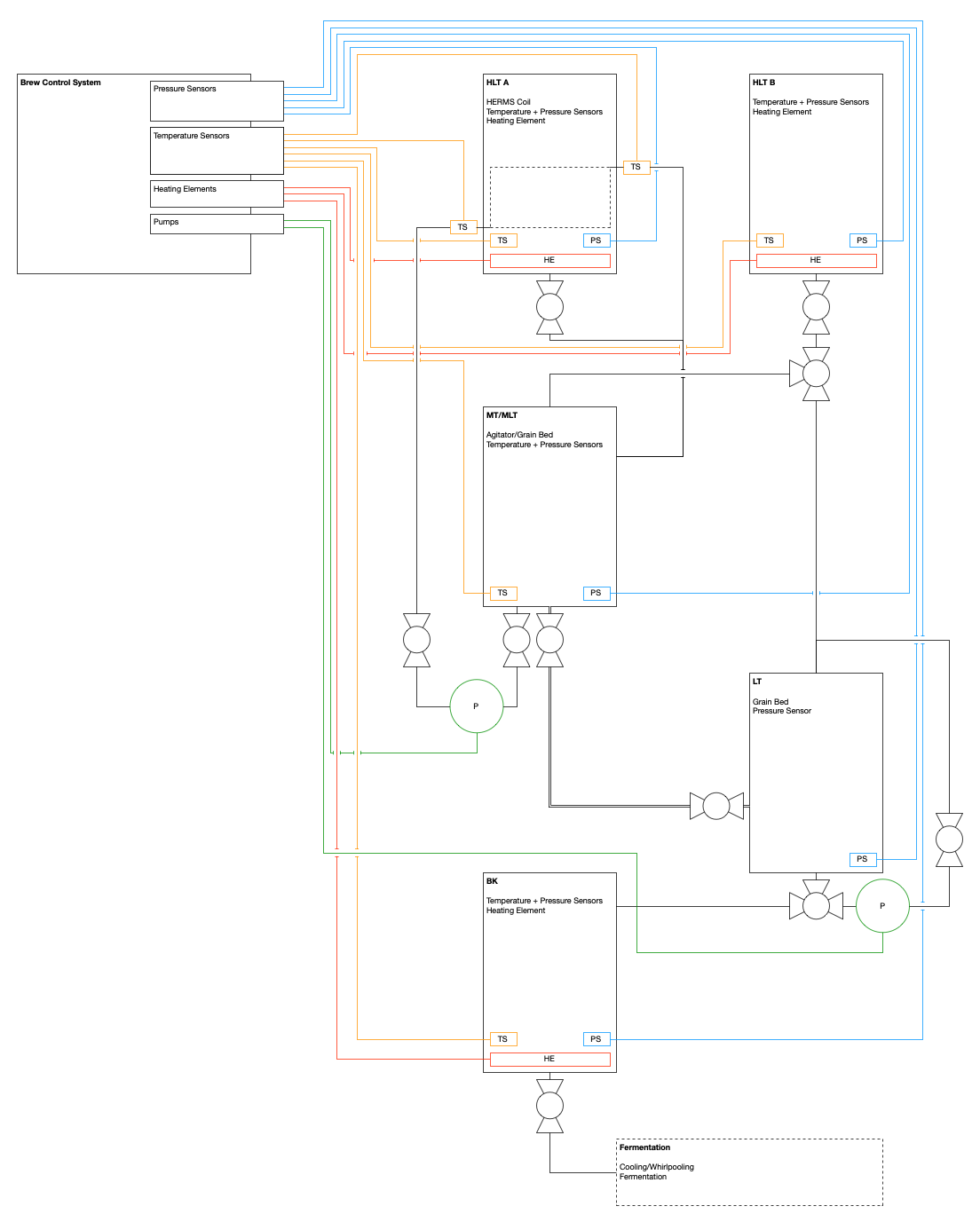kolektiv
Member
Hi folks, I've been posting a few threads here and there picking up tips, but thought I'd start to put a thread together on what I'm trying to do...
In essence, I'm trying to build a very tiny, but very flexible brew system, to help me experiment with all kinds of approaches and techniques - and produce many very small batches, rather than a few large ones. I don't really drink that much anyway, but I do love to experiment, refine, and try new things. So... My plan is to try and construct a multi-vessel brewery, designed to be able to brew several batches in a row, with lots of control. Oh, and it has to fit in a small space not much bigger than a corridor (just in case it was too easy).
So, here's my current layout for the brew phase of things (fermentation, including fermentation prep like cooling, trub extraction, etc. is a separate set of systems):

Some key features:
So! This is the first vaguely workable draft, I'll post some pictures of the vessel and pipework design soon as well, as I'm getting closer to finalising them.
Incidentally the target here is batches around 2 gallons, although I'm trying to give a bit of headroom on various metrics to allow for experimentation with mash densities, high grain loads, double/triple running, etc.
Comments/mockery welcome!
In essence, I'm trying to build a very tiny, but very flexible brew system, to help me experiment with all kinds of approaches and techniques - and produce many very small batches, rather than a few large ones. I don't really drink that much anyway, but I do love to experiment, refine, and try new things. So... My plan is to try and construct a multi-vessel brewery, designed to be able to brew several batches in a row, with lots of control. Oh, and it has to fit in a small space not much bigger than a corridor (just in case it was too easy).
So, here's my current layout for the brew phase of things (fermentation, including fermentation prep like cooling, trub extraction, etc. is a separate set of systems):

Some key features:
- It's gravity driven where possible (not totally, because there are recirculation options, but vessel transfers are all fundamentally vertical)
- The vessels are all essentially 200x200x300mm cuboids - at this size, cylindrical vessels are a nightmare for fittings, ferrules, etc. so I'm going to experiment with square sectioned vessels. Not shown on here - sloped/pyramidal floor designs, particular for the MT.
- It can be used as a fairly standard 3 vessel system just using HLT A, the MT/MLT (using it as a MLT by putting the false floor in the MT, rather than the LT), and allowing the wort to run straight through the LT to the BK. Maybe slightly sub-optimal for aeration, but probably relatively minor. In this configuration, the MLT is a standard 3 vessel MLT with a HERMS system in HLT A, recirculating through the grain bed in the MLT. You can then choose how you want to sparge in the MLT (if you want to).
- It can also be used as a higher throughput system with a separate MT and LT. In this configuration, the MT has an agitator/stirrer like commercial MTs, but still uses HERMS to maintain temperature (with a filtered intake). The whole mash can then be transferred to the LT through the very large "sluice-like" pipe to the bottom of the LT (directly on to the false floor). Hopefully, at least, viscosity experiments pending! The valves can then be closed top and bottom, and the grain bed height adjusted where desired in the LT. Recirculation and then sparging can then take place in the LT, fed by HLT B. This frees up HLT A and the MT to be starting another mash while the general lautering is happening. If there's enough space under the adjustable grain bed it may even be possible to collect the runnings in the LT, and allow for a boil to be happening during at the same time - three brews at once!
- Quite a few vessels use side inlets for transfer, literally only sparging is top down.
- There's a bit less pipework than sometimes used, with some tee joins which "should" work but may one day end up next to a check valve.
- I'm pondering quite heavy use of diaphragm valves for flow control. They're also much more suitable for CIP, and it would be good to eliminate ball valves (ignore the symbols on this diagram, just interpret them as "valve" for now!)
So! This is the first vaguely workable draft, I'll post some pictures of the vessel and pipework design soon as well, as I'm getting closer to finalising them.
Incidentally the target here is batches around 2 gallons, although I'm trying to give a bit of headroom on various metrics to allow for experimentation with mash densities, high grain loads, double/triple running, etc.
Comments/mockery welcome!



